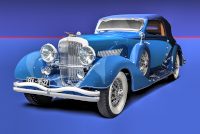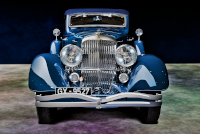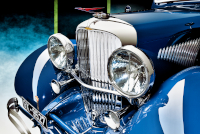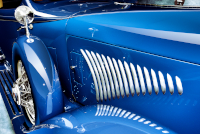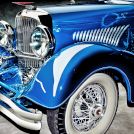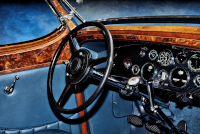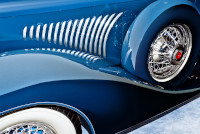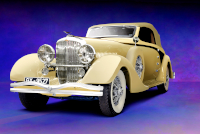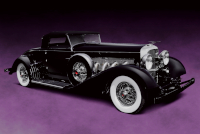Location:
RM Sotheby's, Hershey, 2017
Owner: Thomas F. Derro | Carlisle, Massachusetts
Prologue:
One that got away, we first saw J-519 at the 2006 Radnor Hunt Concours d'Elegance, where I'd toted my trusty film camera and soaked up a mesmerizing automotive assortment with fine film granularity. Not so good for photo-illustrations however, and for many years I hoped to see this Model J once again. The Hershey auction in 2017 finally offered an opportunity to glimpse the car before it moved out of the region, no less alongside the 1933 Silver Arrow I had considered my top priority among all vehicles to profile. I took a rare day off work—at the time providing technical analysis and business case support at a federal financial institution—and drove north for a relaxing afternoon of photos. The results follow a determination to focus on portraits, which fill half this gallery.
So, 16 years after first sight, this J-519 profile finally came together in 2022, focusing on bold two-tone blue compositions spread across lovely steel contours. This car remains my favorite Duesenberg of those I've photographed (no modest number), and stands a close companion in my mind among the finest of those I have not. Of course the first impression, seeing J-519 at my first concours event, counts for a lot. But one of the few examples I think better, at least among those I know of in the vicinity, is J-312, the two-tone Graber-bodied cabriolet.
As I like to build period re-creations, I'm happy to add an imposing perspective based on J-519's original livery (14). I might be a tad too excited about color in this piece, but the coachwork is a Belgian confection for a car originally delivered to the Netherlands; and as both demographics tend toward wacky contrasts anyhow, I like to think the excess color suits the composition. One can't always (and maybe shouldn't ever) photograph classic era cars in front of mansions and castles. So let this image comment on the lost cosmopolitan nature of grand automobiles with echoes of civic buildings I mapped into the background. At left is the mid-18th century Zion Church of the City of Baltimore, and at right the mid-19th century Peabody Conservatory.
- - - - - - - - - -
► Image Source: Nikon D750 (24.3 MP)
References:
- Roe, Fred. "Duesenberg: The Pursuit of Perfection" Dalton Watson Plc, London, UK. 1982, page 221
- Automobile Quarterly's Great Cars & Grand Marques, "Mighty Model J" by Don Vorderman, Automobile Quarterly Publications. Princeton, NJ. 1979, page 19-20
- Automobile Quarterly, Volume 30, Number 4, Summer 1992, "Chariots of the Gods: The Grandeur of the Model J" by Randy Ema, The Kutztown Publishing Company, Inc., Kutztown, PA, page 54
- RM Sotheby's: See the auction description for owner history.
Duesenberg J-519 is the last of the continental Duesenbergs shipped to Paris, and the only Model J bodied by the Belgian firm d'Ieteren Frères of Brussels. The car's singularity is its greatest asset, augmented by its prettiness.
By February of 1935, Duesenberg reduced its export operations to two concessionaires, RSM of London, and E. Z. Sadovich's Motor Deluxe of 12, Rue de Berri in Paris. Both RSM and Motor Deluxe received the few remaining Model J chassis of the time at cost and sold them on consignment. This arrangement signifies the Depression-era toll exacted on Duesenberg, which will face its final, unsurmountable tax bills later in July.
By design, d'Ieteren devised a notch-back cabriolet in the French style, though the nose and tail exhibit somewhat independent influences. Detailed in our aesthetics discussion, one can chart similarities to the Dietrich-era Packard, Hispano-Suiza, and Horch, with cues that will linger through the early days of French coachwork in the post-War era.
Much of what we can and should say about J-519 pertains to aesthetics, the balance of its history filled with owners originally of the Netherlands and later across the United States. I am not driven toward owner histories without some measure of historic significance that allows us to do more than simply parrot what others (such as RM) can tell you. But J-519 does offer an interesting history in terms of its many incarnations, of which this two-tone blue livery is the third.
Motor: 6,876 cc straight 8-cylinder, cast iron block and head | 95.3 mm x 120.7 mm | 5.2:1 compression
Valvetrain: DOHC, 4 valves per cylinder
Power: 265 bhp @ 4,200 rpm
Automobile Quarterly notes that a very early production sample of the Lycoming straight 8-cylinder produced 208 bhp at 3,600 rpm, (pushed no further, as the motor had been scrapped by the factory). Projecting the power curve to 4,200 rpm, the motor's eventual top end, would yield between 245 to 250 brake horsepower, which means the motor's development worked out reasonably in favor of the 265 bhp claimed for production cars, if not a reliable 250 bhp when sorted. Compression for the early scrapped motor was equal to the production motors at 5.2:1.
Front Suspension: solid axle with semi-elliptic leafsprings and hydraulic shock abosorbers
Rear Suspension: live axle with semi-elliptic leafsprings and hydraulic shock absorbers
Architecture: steel ladder-frame chassis with steel coachwork by d'Ieteren Frères of Brussels, Belgium
Wheelbase: 3,898.9 mm (153.5 inches)
Etymology:
Duesenberg identification follows the Lycoming straight 8-cylinder motor number, (here, J-519), whereas the chassis numbers (in this case #2548) tend to remain obscure. The coachbuilder is d'Ieteren Frères of Belgium, who completed steel two-door cabriolet coachwork in the continental style.
Figures:
Our favorite online index listed more than 460 Model J Duesenbergs. Automobile Quarterly supposed Duesenberg produced between 470 and 480. RM suggest 481 known examples. Of late Duesenbergs, J-519 is the last to have been shipped to Paris, and the only Model J with coachwork by d'Ieteren Frères.
Value:
ClassicCarWeekly reports a post-auction sales price of $1,485,000 following RM Sotheby's Hershey auction in 2017.
French School: Continental Influence on a Rare European Duesenberg
Much of the continental influence rests in the hips, where the curve of the body mould joins the high arch of the rear fender. The body surreptitiously flows out to the rear fenders without leaving much flare, a more integrated approach that diminishes the running gear at the back and allows the shape of the car to taper toward the front. The sharp vee scallop on the bonnet top accentuates the taper and wraps elegantly around the flanks, defined at the upper edge by the binding. This gentle sweep down the door is subtle, but with the hood up underpins the notch-back cabriolet design.
At the front, J-519 appears comparable to an early classic era Packard or Hispano-Suiza, (the latter evident in its Marchal headlamps). On the other hand, the tail is a more modern nod to body component integration and high-classic era curves, body shaping that will remain evident in early post-War designs produced for Delahaye and Talbot-Lago by the likes of Figoni et Falaschi and Henry Chapron.
Full Plan: Proportion of the Grand Model J Two-Door Cabriolet
Certain profile perspectives expose the long wheelbase, which is disproportionate for a two-door cabriolet, though not a unique configuration among Model Js. To counteract the length, a tall stance and high arch at the rear wheels pitches the car forward, which, when combined with the low-slung front skirts, creates a sleek approach. Front fenders follow a similar line as seen on Rollston exercises of mildly aerodynamic intent, with a slightly flattened crest, though the overall shape takes influence from Hispano-Suiza. The cabriolet hood follows a more continental style, perhaps most closely the Horch 853, where the ribs create a step-down curve that joins the deck in a pleasant notch-back design.
Original Livery: Illustrating Lost Variations of the d'Ieteren Cabriolet
J-519 appears in Fred Roe's 1982 survey, Duesenberg: The Pursuit of Perfection, where a monochrome profile image from Auburn, Indiana shows the original livery. RM's description states that J-519 had been painted light tan, perhaps cream, over the body, with a darker tone on the moulded accent. This café au lait body sat on a blue chassis. I've taken the Fred Roe image as the basis for a period representation (14). From the monochrome image, I interpret the upper bout and deck as having been the same overall light tone. I did not illustrate the louvres in silver, as they are today.
Note however that in its original configuration J-519's French curve appears to broaden at the hips, with a sharper curve and elongated decline toward the leading edge of the rear skirt. This change in body shaping is peculiar, and makes me wonder when we lost the original characteristic of that French curve, as the car has been restored twice since. Based on the tonal shading in the period photograph, the rear fender skirts might also have matched the darker French curve, though I kept the tone consistent with the lighter color—all very dodgy, trying to determine color from greyscale tones.
After the original tan two-tone paint, a mid-1970s restoration changed the livery to two-tone red. Restored a second time in the mid-1990s, J-519 adopted its present two-tone blue livery. RM reports J-519 owes its most elegant color selection to long-time General Motors designer David R. Holls. Nicely done, the colors roll over d'Ieteren's steel coachwork with the smooth finesse of fondant sealed over a cake.
Last Updated: Mar 26, 2025

